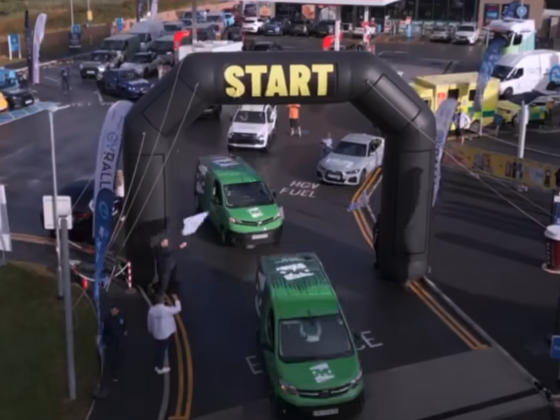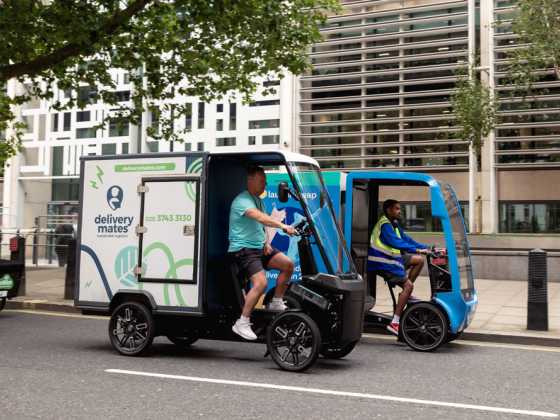Commercial vehicles: the new weapon of choice in terror attacks?

Vehicles were used in three of the five terror attacks that took place in London and Manchester in 2017. To tackle this worrying trend, the Department for Transport has released guidance for transport operators to prevent their vehicles being used as a weapon
In the last five years, commercial vehicles have become one of the deadliest weapons used by terrorists across Europe.
In 2017, vehicles were used in three of the five attacks which took place in London and Manchester.
It is therefore vital that transport businesses adopt a responsible approach to security.
To support transport operators to mitigate the threat of their vehicles being used in an attack, the Department for Transport (DfT) has worked alongside security experts from Counter Terrorism Policing to create a guidance document.
The guidance outlines the steps organisations can take to prevent their vehicles being used in a terror attack.
The guidance covers all aspects of vehicle and site security, including a checklist for vehicle security for commercial drivers.
What is a Vehicle as A Weapon attack?
A vehicle can be used as a weapon intentionally to injure and kill people. This is referred to as a ‘vehicle as a weapon (VAW) attack’.
VAW is a low complexity methodology requiring little or no training. With a plentiful source of vehicles on UK roads, it is therefore within the capability of individuals to try and steal one and use it in an attack.
Crowded public spaces are targeted by this type of attack. There are a range of online terrorist and extremist materials aimed at inspiring terrorists to carry out VAW attacks and previous attacks have encouraged copycats, who now see VAW as a successful means to cause terror. Lorries and vans pose an increased risk if used in VAW attacks because of their size, profile and weight, all of which increase the potential impact.
Embedding a security culture
Being vigilant and reporting suspicious behaviour increases the likelihood that people with hostile intentions will be detected or deterred. An organisation therefore needs to have procedures in place for reporting any unusual behaviour.
The National Counter Terrorism Policing (NCTPHQ) Action Counters Terrorism (ACT) campaign urges people to report anything that could suggest a terrorist threat to the UK. Suspicious activity can be reported to the police by calling confidentially on 0800 789 321 or through the campaign page: https://act.campaign.gov.uk.
Security responsibilities should be allocated to a staff member who has appropriate authority to make security related decisions and implement them.
The risks posed by an organisation's vehicle operations should be assessed with the involvement of customers, shippers, freight forwarders, carriers, security service providers, and insurance experts, if possible.
Identify possible solutions that will prevent one of your vehicles being used in an attack and get feedback from drivers. Any security plans should be reviewed regularly.
Countering the insider threat
An insider is a person who exploits, or has the intention to exploit, their legitimate access to an organisation’s assets for unauthorised purposes.
Insiders with access to an organisation's processes and assets can be a source of threat. An insider could be a full time or part-time employee, a contractor or even a business partner. They could deliberately join an organisation to gain access to its assets to mount an attack, or they may be triggered to act at some point during their employment.
Consideration should be given to using British Standard 7858 (or equivalent) for security screening of employees. This standard involves conducting basic identity, financial, employment and criminal records checks.
The guidance also recommends that a driver’s references and previous employment history (minimum of five years) is checked and that the employer speaks to previous employers. It suggests informing applicants that false details on application forms may lead to dismissal.
Driving licences should be checked for validity and then at six-monthly intervals afterwards. Drivers should inform employers of any changes to their licence. Check if the applicant has any prosecutions pending or is waiting for sentencing by a court. For agency drivers, ensure that the agency has carried out all of these checks including criminal records checks. What's more, only reputable recruitment agencies that are affiliated with a recognised UK trade organisation should be used.
Site Security
Effective security measures at operating centres and maintenance facilities can help to create a controlled environment to prevent vehicles being stolen and potentially used in terrorist attacks.
Organisations can consult their local Counter Terrorism Security Advisers (CTSAs) to agree a system for reporting and dealing with suspicious vehicle incidents, and liaise with them regarding securing their sites. CTSAs work with businesses and the community to identify and assess sites that may be vulnerable to terrorist or extremist attack. They also work with trade organisations and professional bodies to ensure counter terrorism protective security advice is incorporated into general crime prevention advice and guidance.
Basic security measures can help to ensure that an item is not concealed on board a vehicle when in maintenance centres. Having clear signage in place can discourage unwanted access by vehicles and people.
Other site security measures include fitting locks or tamper proof seals to lockers and equipment boxes. Access to operating centres should be controlled with appropriate security arrangements i.e. fences, gates, security codes. What's more, vehicle keys should be stored in a secure locker with security codes. Keys should not be left in vehicles or on hooks in the office easily accessible to anyone
All visitors and contractors accessing the premises should be required to report to reception or an individual in authority to notify their arrival.
Visitors should sign-in, be issued visitor passes and have a legitimate reason for their visit. These identification passes should be worn and ‘be visible’ at all times, anyone not wearing a pass should be asked by a member of staff why they are not wearing a pass. Visitors should be escorted at all times when not in public areas.
This process provides audit information, including sign in/out times and the purpose of the visit, and can be crucial in the event of an emergency evacuation of the premises.
Visitors and contractors should be given a security awareness briefing, explaining that passes are displayed prominently at all times, and that anyone without a pass or in an unauthorised area will be challenged. They should be told that all doors should be properly closed when leaving, particularly doors leading to non-public areas, and to report any suspicious activity.
If an organisation's vehicles are repaired and maintained off site, site security must be appropriate. Maintenance staff, including sub-contractors should be made aware of your company’s vehicle security policies and procedures. The maintenance agreement between the vehicle operator and the vehicle maintenance company should include a duty to secure the vehicles and keys correctly.
CCTV is central to most modern security systems. Its primary purpose is to detect suspicious activity and act as a verification system for other security measures. CCTV can be a single or combination of systems and technologies to form the overall security solution.
The DfT recommends using an electronic detection system assured by CPNI, which can be sourced from the CPNI Catalogue of Security Equipment (CSE). Most of these work on the five-minute rule. This assumes that each part of a perimeter or sensitive asset is viewed by either a guard or CCTV once every five minutes. This limits the potential time for an unauthorised activity and forces an attacker to act rapidly, making them more likely to trigger an electronic detection system.
Vehicle Security
Drivers should visually check their vehicle at the beginning and end of their journey, looking for any signs that something has been concealed or tampered with.
At the start and end of a journey, during a comfort break or whilst parked as securely as possible, drivers should ensure that all the doors and windows are closed, engine switched off and ignition keys are taken with them. For vehicles not requiring ignition keys, drivers should ensure that they secure the vehicle appropriately before leaving.
For vehicles that require the engine running to operate auxiliary equipment, the driver should take appropriate measures to ensure against theft of the vehicle; this could include the provision of a second key to lock the cab doors.
Security features that keep the driver and vehicle safe and secure should be considered during the vehicle procurement process.
The decision will depend on what type of operations are being undertaken. A vehicle being used to multi-drop in a town centre might need to be fitted with an ignition immobiliser, while an international haulage operator might need to think about load space monitoring.
The operator must decide what security and safety equipment is most appropriate for their vehicles, from sophisticated electronic engine immobilisers and in-cab cameras to simple steering locks: anything that deters the theft of the vehicle should be considered.
If a vehicle is stolen, the driver should call 999 and explain the circumstances of the vehicle being stolen and a description of the vehicle including company name, registration details, aerial roof markings and any tracking software fitted in the vehicle. If the driver suspects that the vehicle has been stolen for a terrorist attack then make sure this is made clear to the call handler.
Drivers should also immediately alert the company who will have procedures in place for stolen vehicles.
Security tips for Goods Vehicle Drivers
Avoid talking about loads or routes with unauthorised persons (including over radios and telephones). Do not post information about your route or location on social media, be aware of your ‘digital footprint’, and take care to avoid unwitting disclosure of route/location through mobile phone security settings and geolocation of pictures. Discuss high risk routes with you transport office.
Lock and secure your vehicle whenever you leave the cab and keep the keys secure, including when unloading and loading, always follow company security policies and instructions.
Carry out visual walk around checks when leaving and returning to the vehicle to make sure it has not been tampered with. Report any irregularity in loading, locking, sealing or documentation to your Company.
When conducting walk around checks, think Security as well as Safety.
Never carry goods for anyone, other than the authorised load.
If you are forced to change your route, inform your Transport Office immediately.
If someone is acting suspiciously or something ‘doesn’t feel right’ either at the depot or on the road, report it to ACT, call 0800 789 321 and contact your company.
Do not allow unauthorised passengers into the cab.
Keep your phone fully charged and on you at all times. Store important phone numbers.
Be mindful of your personal security. Keep ID documentation and wallets secure and out of sight.
Beware of attempts to deceive, such as by bogus Police and DVSA Officers.






